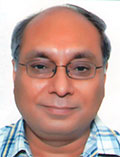Nepal Earthquake of 25th April 2015: Remote Sensing in Detection of Pre-Earthquake Anomalous Thermal Line and Co-Seismic Ground Deformations

Prof. Arun Kumar Saraf
Head of the Department of Earth Sciences,
Indian Institute of Technology, Roorkee. ROORKEE - 247667, Uttarakhand, India
Nepal Earthquake of 25th April 2015: Remote Sensing in Detection of Pre-Earthquake Anomalous Thermal Line and Co-Seismic Ground Deformations
Arun K. Saraf, Suman Baral, Josodhir Das*, Eirin Kar, Gaurav Singh and Susanta Borgohain
Department of Earth Sciences,
*Department of Earthquake Engineering,
Indian Institute of Technology Roorkee
ROORKEE-247667, INDIA
ABSTRACT
On 25th April, 2015 at 11:41:26 (local time) a major and shallow earthquake (28.147°N, 84.708°E) of Mw 7.8 (focal depth ≈ 15km) struck Nepal (at 34km ESE of Lamjung and approximately 80 km northwest of Kathmandu). So far more than 156 aftershocks (75 above magnitude 4.5) have already occurred and the biggest aftershock was of Mw 7.3 (occurred again at 15km depth and 18km SSE of Kodari, Nepal) on 12th May 2015 at 12:35:19 (local time). The rupture started at the epicenter and then propagated eastward for about 150 km, rupturing the area directly located under the capital city Kathmandu of Nepal. The aftershocks are distributed in an area about 150 km long and 50 km wide, with the majority of the aftershocks located in the eastern part of the epicentre of the main shock. As per Ministry of Home Affairs, Govt. of Nepal, this earthquake has already caused 8631 loss of human lives, 16808 people got injured and thousands of people have become homeless due to complete / partial damage of 766109 houses / buildings. There are more than 90 deaths in India too, mainly in Bihar. This earthquake has also caused massive damage to houses, roads, bridges, government buildings, schools, hospitals, wide-spread landslides and probable liquefaction at places. Time series analysis of NOAA-AVHRR thermal infrared night-time datasets has revealed appearance of a thermally enhanced linear band / 'thermal line'. Earlier while studying 29 March 1999, 6.4 Mw Chamoli Earthquake, India, similar anomalous thermal line was also observed and we termed as 'Himalayan Thermal Line' (HTL), in the zone of the Himalayan foothills (SW of epicentre). This anomalous distinct line appeared about 3 days before the 25th April 2015 Nepal earthquake. It is important to note that HTL closely follows the frontal thrust in the Himalayan tectonic belt. The narrow zone that follows the thermal line consists of soil, with very high moisture content, believed to be derived mainly from weathering of the rising Himalayan front. The HTL shows gradual rise of the thermal regime during a period coinciding with the 25th April 2015 Nepal earthquake. This might be due to enhanced tectonic activity in the region due to ongoing northward Indian plate movement. During an earthquake preparation phase, compressional tectonic regime may cause expulsion of moisture to the surface from depth along fracture systems serving as conduits for transient warmer fluid flow. Hence, the warmed up soil zone plays a role in enhancing thermal infrared emission that appear as a linear belt on the series of satellite thermal images. Normally due to the moisture content of soil, this region remains warmer than the surroundings during nighttime. The appearance of the HTL, especially south-west of the epicentral region indicates higher tectonic stress conditions and can be attributed to the 25th April 2015 Nepal earthquake. Further, InSAR analysis of Sentinel-1A radar satellite revealed significant ground deformation of more than 1m (uplifted in the line of sight) has taken place near the capital of Nepal (in Kathmandu valley, approximately 80 km southeast of epicentre). Damage in Kathmandu is attributed to local geological setup and prevailing soil conditions which are prone to liquefaction and amplified shaking.
Keywords: NOAA-AVHRR, Himalayan Thermal Line (HTL), Himalayan Frontal Thrust (HFT)
BIO
Dr. Arun K. Saraf is Ph. D. (Remote Sensing) from University of Dundee, United Kingdom. Presently he is working as Professor and Head in the Department of Earth Sciences, Indian Institute of Technology, Roorkee, India and teaches courses on GIS, Remote Sensing, Geomorphology etc. to under- and post-graduate students of Applied Geology and Geological Technology. He was first in the country to introduce GIS course to post-graduate students in the year 1990. In 1986, he was awarded "National Fellowship to Study Abroad" by Govt. of India for his doctoral degree. Further, in 1994 he was awarded "Indo-US S&T Fellowship" and worked in Goddard Space Flight Centre, NASA, USA for Post Doctoral Research. He has been also awarded "National Remote Sensing Award-2001" by Indian Society of Remote Sensing and "GIS Professional of the Year Award-2001" by Map India 2002 for his outstanding research contributions in the fields of Remote Sensing and GIS. Earlier, he has also been given several Khosla Research Awards and Prizes by then University of Roorkee. So far Prof. Saraf has published more than 80 research papers in journals of repute (ISI) and supervised 10 Ph.Ds. Presently, he is also Associate Editor of International Journal of Remote Sensing. Through funding from DST and Min. of Earth Sciences, Govt. of India, Prof. Saraf has been able to establish NOAA-HRPT Satellite Earth Station at IITR, first in any educational institute in the country.
Keynote Speakers' List• Abstracts Proceedings (Final)
• Complete Conference Program (Final)
See All...
Submission of abstracts: 30 September 2015
Notification of acceptance: 15 October 2015
Full papers submission: 31 October 2015
Early bird registration extended to: 31 October 2015
Registration Deadline: 30 November 2015
Conference Documents



















